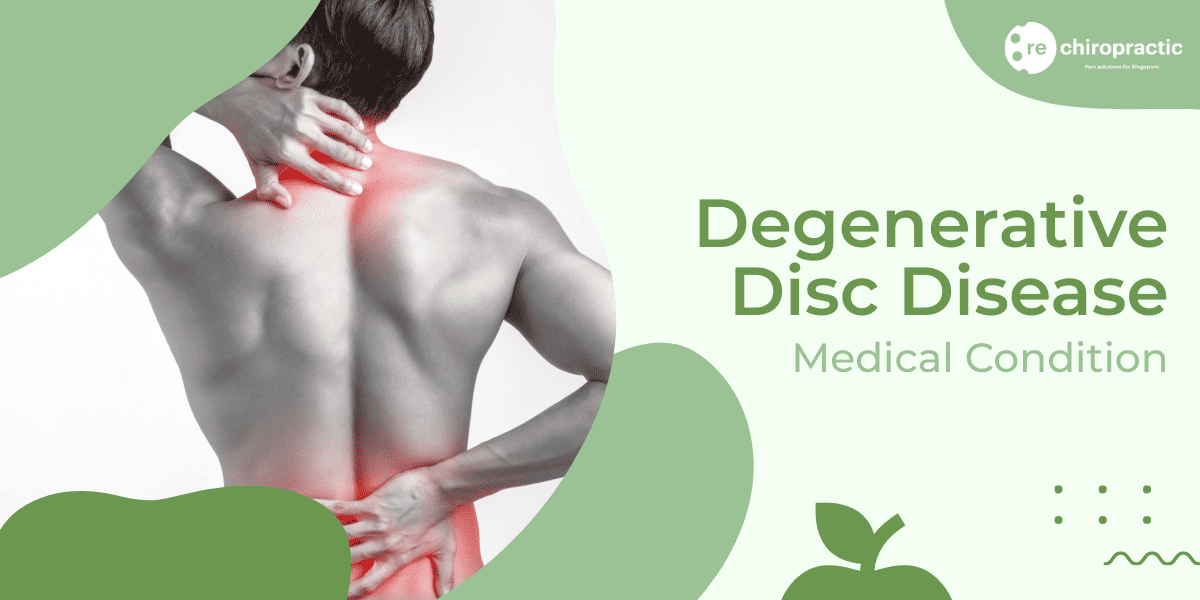
Degenerative Disc Disease
Degenerative Disc Disease, also known as DDD, is a common condition that affects the intervertebral discs of the spine. These discs act as shock absorbers between the vertebrae, allowing for flexibility and movement of the spine. Over time, these discs can degenerate, leading to pain and discomfort.
As we age, the discs in our spine naturally lose their water content, making them less flexible and more prone to damage. This can result in the development of small tears or cracks in the outer layer of the disc, known as the annulus fibrosus. When this happens, the gel-like substance in the center of the disc, called the nucleus pulposus, may leak out and irritate nearby nerves, causing pain.
Degenerative Disc Disease can occur in any part of the spine, but it is most commonly found in the lower back (lumbar spine) and the neck (cervical spine). The condition can range from mild to severe, and the symptoms can vary from person to person.
Degenerative Disc Disease is a normal part of the aging process and is not necessarily a disease. It is estimated that by the age of 60, over 90% of people will have some degree of degeneration in their spinal discs.
Symptoms & Different Stages of Degenerative Disc Disease
As degenerative disc disease progresses, individuals may experience various symptoms that can range from mild discomfort to severe pain. It is important to understand the different stages of this condition in order to identify the appropriate treatment options. Here are the common symptoms and stages of degenerative disc disease:
- Stage 1: Disc Degeneration: In the initial stage, individuals may not experience any noticeable symptoms. However, the discs in the spine start to show signs of wear and tear, leading to a loss of fluid and elasticity. This stage is typically characterized by minor disc bulging or small tears.
- Stage 2: Discogenic Pain: As the condition progresses, individuals may start to experience pain and discomfort. The pain is often localized to the affected area of the spine and may worsen with certain movements or activities. Common symptoms include dull or achy pain, stiffness, and muscle spasms.
- Stage 3: Spinal Instability: In this stage, the degeneration of the discs can lead to instability in the spine. This instability may cause the vertebrae to shift or misalign, resulting in more pronounced pain and limited mobility. Individuals may experience shooting pain, numbness, tingling, or weakness in the arms or legs.
- Stage 4: Advanced Degeneration: At this advanced stage, the discs may become significantly thinner and lose their ability to cushion the vertebrae. This can lead to bone-on-bone contact, causing severe pain and limited mobility. Individuals may also experience nerve compression, which can result in radiating pain, numbness, or weakness in the extremities.
While degenerative disc disease is a common part of the aging process, certain signs that may indicate the need for medical intervention. If you experience any of the following symptoms, it is advisable to seek medical attention:
- Severe or worsening pain that does not improve with rest or conservative measures.
- Pain that radiates down the arms or legs, accompanied by numbness or weakness.
- Difficulty controlling bowel or bladder function.
- Unexplained weight loss or fever.
Identifying these warning signs and seeking prompt medical evaluation can help prevent further complications and ensure appropriate treatment for degenerative disc disease.
Most Common Causes of Degenerative Disc Disease
Degenerative disc disease is a condition that occurs when the discs between the vertebrae in the spine begin to break down and deteriorate. While the exact cause of this condition is not always clear, there are several factors that can contribute to its development. Here are some of the most common causes:
- Age: One of the primary causes of degenerative disc disease is simply the natural aging process. As we get older, the discs in our spine lose their ability to absorb shock and provide cushioning between the vertebrae. This can lead to the discs becoming thinner and more susceptible to damage.
- Genetics: Some individuals may be genetically predisposed to developing degenerative disc disease. Certain genetic factors can make the discs more prone to wear and tear, increasing the risk of this condition.
- Repetitive Movements: Engaging in repetitive movements or activities that place excessive stress on the spine can contribute to the development of degenerative disc disease. This includes activities such as heavy lifting, bending, and twisting.
- Injury or Trauma: In some cases, degenerative disc disease can be caused by a specific injury or trauma to the spine. This can include accidents, falls, or sports-related injuries that result in damage to the discs.
- Poor Posture: Maintaining poor posture over time can put added pressure on the discs in the spine, accelerating the degenerative process. Slouching, hunching, and sitting for long periods without proper support can all contribute to the development of this condition.
While these factors can increase the risk of degenerative disc disease, they do not guarantee its development. Each individual is unique, and the presence of these causes does not necessarily mean that someone will develop this condition. However, understanding these common causes can help individuals make informed decisions about their spinal health and take proactive steps to prevent or manage degenerative disc disease.
How Bad Can Degenerative Disc Disease Get?
- Chronic Pain: If left untreated, degenerative disc disease can worsen over time, leading to chronic pain. This pain can become debilitating, affecting daily activities and quality of life.
- Reduced Mobility: As the condition progresses, the discs in the spine continue to deteriorate, causing a loss of flexibility and range of motion. This can make it difficult to perform simple tasks such as bending, twisting, or lifting.
- Nerve Compression: As the discs degenerate, they may bulge or herniate, putting pressure on nearby nerves. This can result in radiating pain, numbness, tingling, or weakness in the affected area and down the extremities.
- Spinal Instability: Severe degenerative disc disease can lead to spinal instability, where the affected discs no longer provide proper support to the spine. This instability can result in abnormal spinal movements and potentially lead to further complications such as spinal stenosis or spondylolisthesis.
- Loss of Height: The discs act as cushions between the vertebrae, providing space and maintaining the height of the spine. As degenerative disc disease progresses, the discs shrink and lose their ability to maintain height, resulting in a gradual loss of overall height.
Progression and severity of degenerative disc disease can vary from person to person. Some individuals may experience mild symptoms and slow progression, while others may face more severe consequences. Early intervention and appropriate treatment can help manage the condition and prevent it from reaching advanced stages.
Chiropractic for Degenerative Disc Disease
Chiropractic care offers a holistic approach to managing degenerative disc disease, focusing on relieving pain, improving mobility, and enhancing overall quality of life. This non-invasive and drug-free treatment option aims to address the root cause of the condition rather than simply masking the symptoms.
- Spinal adjustments: Chiropractors utilize gentle spinal adjustments to realign the vertebrae and discs. By restoring proper alignment, pressure on the affected discs is reduced, alleviating pain and promoting healing.
- Spinal decompression: This technique involves the use of a traction table or specialized equipment to gently stretch the spine. By creating negative pressure within the discs, spinal decompression helps to relieve pain and pressure on the affected discs.
- Massage therapy: Massage techniques can help relax tense muscles and improve blood circulation, which can aid in reducing pain and inflammation associated with degenerative disc disease.
- Exercise and rehabilitation: Chiropractors may prescribe specific exercises and stretches to strengthen the muscles supporting the spine. This helps improve stability and flexibility, reducing the strain on the affected discs.
- Lifestyle recommendations: Chiropractors often provide guidance on ergonomics, posture, and other lifestyle modifications to minimize stress on the spine and promote optimal spinal health.
Chiropractic care can play a crucial role in managing degenerative disc disease by providing drug-free pain relief and improving spinal function. However, it is important to note that every individual is unique, and treatment plans may vary based on the severity and stage of the condition. Consulting with a qualified chiropractor will ensure personalized care tailored to your specific needs.
Self Help & Relief for Degenerative Disc Disease
- Exercise regularly: Engaging in low-impact exercises such as walking, swimming, or cycling can help strengthen the muscles around the affected area and improve flexibility. It is important to consult with a chiropractor or physical therapist to determine the most suitable exercises for your condition.
- Practice good posture: Maintaining proper posture throughout the day can reduce the strain on your spine and alleviate symptoms. Avoid slouching or sitting for extended periods, and use ergonomic chairs or lumbar supports to support your lower back.
- Apply heat or cold therapy: Applying a heating pad or taking warm baths can help relax the muscles and provide temporary relief from pain. Alternatively, cold packs or ice packs can help reduce inflammation and numb the area.
- Use proper lifting techniques: When lifting heavy objects, it is crucial to use your legs instead of your back to minimize strain on the discs. Bend at the knees, keep the object close to your body, and avoid twisting while lifting.
- Maintain a healthy weight: Excess weight puts additional stress on the spine and can exacerbate symptoms of degenerative disc disease. By maintaining a healthy weight through a balanced diet and regular exercise, you can reduce the strain on your discs.
- Practice stress management techniques: Chronic stress can contribute to muscle tension and worsen symptoms. Engage in stress-reducing activities such as meditation, deep breathing exercises, or yoga to promote relaxation and alleviate discomfort.
- Use supportive pillows and mattresses: Investing in a supportive pillow and mattress can help maintain proper spinal alignment while sleeping, reducing the pressure on your discs. Look for pillows and mattresses that provide adequate support for your neck and back.
- Avoid smoking: Smoking can impair the blood flow to the spinal discs, hindering their ability to receive essential nutrients and heal. Quitting smoking can improve the overall health of your spine and potentially slow down the progression of degenerative disc disease.
When to Seek Medical Attention for Degenerative Disc Disease
If you are experiencing persistent pain or discomfort in your back or neck, it is important to seek medical attention for a proper diagnosis and treatment plan. While there are self-relief methods that can help alleviate symptoms, living with chronic pain is not something that should be endured.
When the pain from degenerative disc disease starts interfering with your daily activities and quality of life, it is time to consult a healthcare professional. They will be able to assess your condition, provide a proper diagnosis, and recommend appropriate treatment options.
In addition to seeking medical attention, it is important to be aware of certain red flags that may indicate a more serious underlying condition. If you experience any of the following symptoms along with your back or neck pain, it is crucial to seek immediate medical attention:
- Severe or worsening pain
- Pain that radiates down your legs or arms
- Numbness or tingling in your extremities
- Difficulty controlling your bladder or bowels
- Unexplained weight loss
- Fever or chills
Remember, living with degenerative disc disease doesn’t mean you have to live with pain. Seeking medical help from a healthcare professional, such as a chiropractor, can provide you with the necessary guidance and treatment options to manage your symptoms effectively. Don’t hesitate to reach out for help and take control of your health and well-being.

Dr. Jenny Li is America trained chiropractor who specialises in sports injury, sports performance, and spinal health. She graduated from Palmer College of Chiropractic in United States, upon completion of the her post graduate program she practiced in Hong Kong and currently is practicing in Singapore.

